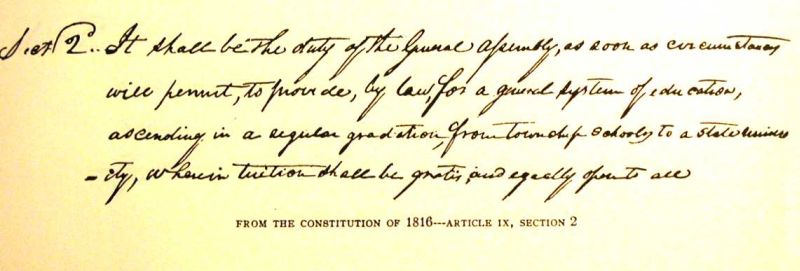
Article 9, Section 2, in Dr. Maxwell's own handwriting
29 June 2006. We received the following article from its author, cousin Howard Maxwell, who generously permitted us to include it in this Carey Family Album:
On this day in 1816 Indiana's first state constitution was adopted at the old statehouse at Corydon.1 One notable provision was Article 9, Section 2, which described the state's obligation to educate all of its citizens, and written into Indiana's constitution by Dr. David H. Maxwell,2 a delegate from Jefferson County, as follows:
Article IX, Sect. II. "It shall be the duty of the General assembly, as soon as circumstances will permit, to provide, by law, for a general system of education, ascending in a regular gradation, from township schools to a state university, wherein tuition shall be gratis, and equally open to all."
Creation of the 1816 Constitution
The Ordinance of 1787 establishing the Northwest Territory set a number of criteria which individual territories had to meet in order to qualify for statehood; the principal one was that the population of the area had to reach a total of 60,000 free inhabitants. When the Indiana Territory met those criteria, the US Congress passed an enabling act on 19 April 1816, authorizing it to adopt a state constitution and form a state government.3
On 13 May following, forty-three delegates for the constitutional convention were elected. They met in Corydon, Harrison County, on June 10th and adjourned soon after, on June 29th, their work finished. The delegates were able to work so quickly because they essentially adopted a standard constitution. For the most part, they simply copied from the Ohio Constitution of 1802 and the Kentucky Constitution of 1799. The total cost of the convention was $3,076.21.
The result, Indiana's Constitution, was never submitted to the people for ratification; it took effect immediately on the day the convention adjourned. Elections of state officers and members of the General Assembly followed soon after, on August 5th. The first General Assembly convened on November 4th and the first governor, Jonathan Jennings, assumed office on November 7, 1816.
Two handwritten copies of the Constitution were made by the convention's secretary, Dr. Maxwell. One of these was given to Jonathan Jennings, President of the Constitutional Convention and Indiana's first Governor. On November 11, 1816, Jennings delivered the copy to the first General Assembly, which ordered it deposited with the Secretary of State. The "official" copy remained with the Secretary of State until 1934, when it was transferred to the Indiana State Archives.
Dr. David Hervey Maxwell, HOUSE, 1821-22, 1823-24 (Speaker), 1825 (MONROE); SENATE, 1826-27, 1827-28, 1828-29, 1829-30 (Greene, MONROE, and Owen). (Brother of Edward R. Maxwell, uncle of David Maxwell Dunn, Samuel Campbell Dunn, and William McKee Dunn, this volume) Born September 17, 1786, Lancaster, Garrard County, Kentucky, of Scotch-Irish ancestry. Attended country schools; studied medicine, Danville, Kentucky; Married Mary E. Dunn, 1809 (4 children). Presbyterian. War of 1812: surgeon. Moved to Jefferson County, Indiana, in 1810; and to Bloomington, Monroe County, in 1819. Physician; banker. Pro-Adams; Anti-Jackson; Whig. Member, Constitutional Convention, 1816; Bloomington postmaster, 1825-29, 1841-45, 1849-52; member, Board of Internal Improvements, 1836-37; mayor of Bloomington, 1848; lost for lieutenant governor, 1822. Trustee, Indiana University, 1820-37, 1839-52, president of the board, 1820-37, 1841-52.4
One of the four candidates running against Dr. Maxwell was Ratliff Boone, a second cousin of pioneer explorer Daniel. Dr. Maxwell died May 24, 1854 and was buried at Rose Hill Cemetery in Bloomington close to his brother, John Maxwell, who died at Bloomington in 1824 of tuberculosis.

Article 9, Section 2, in Dr. Maxwell's own handwriting